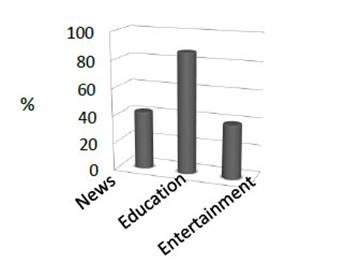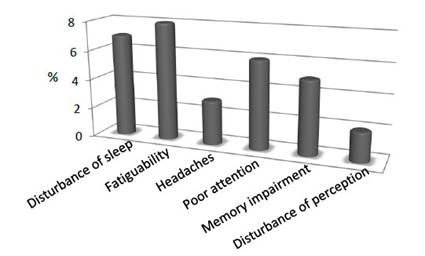Introduction
During the period of socio-economic and spiritual-cultural changes in modern society, there is an intensive increase of Internet resource use in various spheres of human life. The problem of student youth modern generation interaction with the Internet environment is more relevant than ever. The students of higher educational institutions feel the need for the availability of the necessary virtual information and the provision of social connections online. The process of an individual socialization takes on a "cyber-active" character.
According to Pleshakov (2012), for modern youth - the active users of social networks and other resources of the Internet environment - life activities are organized and cognitive abilities develop differently from the "cybersterile" representatives of the population, they perceive the world around them differently. It is not only about the skills of modern information and communication technologies and computer equipment mastering, but also about the changes of the conceptual field and diverse representations, and world outlook in the fundamental spiritual and cultural structures.
The definition of "cyber socialization" (virtual computer socialization) was first introduced in 2005 by the Russian scientist, the candidate of pedagogical sciences, professor V.A. Pleshakov from FSBEI HE "MPGU". He defines "cybersocialization" as a local process of qualitative changes in the personality structure that occurs as the result of a person’s socialization in cyberspace, a virtual socializing Internet environment, that is, in the process of its resource use and the communication with virtual socialization agents that a person encounters on the global Internet (first of all, in the process of correspondence by e-mail, in forums, in chat rooms, blogs, newsgroups and online games).
Currently, the definition of "personality cyber socialization" is being refined as follows (from the English Cyber - associated with computer and digital technologies, in particular, with the global Internet, the prefix that is used referring to various electronic and/or network resources, information, objects, events when the thing is about computer technology + socialization) - the socialization of personality in cyberspace as the process of qualitative changes in the structure of personality self-awareness and the need-motivational sphere of individual occurring under the influence and as the result of human use of modern information and communication, digital and computer technology in the context of learning and reproduction of culture within the framework of the personal life activity (Pleshakov, 2005).
As an alternative term in foreign psychology, they use the concept of "virtual socialization". Saleem (2016) considers this phenomenon as the factor in the transformation of modern man consciousness. In the studies of American scholars, the process of cyber socialization is analyzed exclusively from a positive position and its negative influence on the personality is refuted (Horrigan & Rainie, 2006; Owence, 2017).
The theory of human cyber socialization is based on the principles of an integrative approach within the framework of the concepts of pedagogy and personality psychology (psycho- age ontology), based on the leading positions of scientific schools: "Social education in the context of socialization", "Person-oriented professional education", "Phenomenology of personality development and existence", "Psycho flexibility of personality in education".
The cyberontological concept of personality and modern person life development is called upon to justify the potential of socializing, training and educational opportunities of information and communication technology application based on sociocultural, age, gender, ethnic-confessional, personal and individual characteristics of a person (Pleshakov, 2010).
Applied branches of cyber psychology and media pedagogy are developing rapidly, and combine the research methodology, theory and practice of social Internet service types, methods and principle use for personal development (Voiskounsky, 2013).
Today, no one is surprised by the active use of the following terms and phrases: "cyber attack", "cyber security", "cyber sport", "cyber threat", "e-democracy", "cyber crime", "cyber terrorism", "electronic journal", "cyber economics", "cyberspace" and other similar neologisms not only in speech of scientists, journalists, politicians, businessmen, but also in the everyday communication of people.
Foreign researchers describe the positive impact of cyber socialization on the communicative development of people. Due to the Internet space, social connections have no time and territorial restrictions. In addition, the Internet environment allows people with disabilities to use its resources for work and communication (Howe, 2008; Bower, 2006).
The factors of cyber socialization can be represented on the basis of the classification of general socialization factors by A.V. Mudrik, who identified megafactors, macro factors, mesofactors, and microfactors of the social environment that influence the development of personality. Based on this classification V.A. Pleshakov identifies the factors of cyber socialization of personality. He defines cyberspace, the global Internet and cellular communication as megafactors. The macro factors are represented by the national domain zone, the mail services of the Internet environment, social networks of the Internet environment, Internet portals and sites, the search engines of the Internet environment, file-sharing networks, online advertising, the blogosphere, and massive multiplayer online games (Pleshakov, 2010)
Pleshakov (2012) relates wiki projects and Internet dictionaries, Internet television and Internet radio, IP telephony and video calls via computer networks and cellular communications, Internet forums as a space for cyber-communication with its specific characteristics, instant messaging and chat rooms, Internet-stores, online auctions and electronic payment systems, computer (and/or console) games to the mesofactors of cyber socialization.
Pleshakov (2012) singles out the software for personal computer equipment and cellular (mobile) telephones, a personal cyberspace zone, and game characters in a computer game as the microfactors of cyber socialization. The components of the personality cyber socialization model in the modern information society, represent a person:
as an object of cyber socialization (the impact of cyberspace on livelihoods);
as a subject of cyber socialization (meeting the needs in cyberspace);
as a victim of cyber socialization (negative consequences);
as a victim of cyber socialization unfavorable conditions (the dangers of cyberspace and their sources).
Conditions, Materials and Methods of Research
An empirical study of students' subjective perception of activities in the information and communication Internet space was carried out in the Stary Oskol branch of Belgorod State National Research University. The respondents were 112 full-time bachelors of the full-time education at pedagogical faculty (PF) and 86 students of the Faculty of Economics and Management (FEM), 198 respondents in total. The age of the empirical study participants was 19-22 years old, of which 84 were boys and 114 were girls.
Students' subjective perception of activities in the information and communication Internet space was determined using the questionnaire that included questions about the attitude to the means of cyber environment, the assessment of the usefulness and effectiveness of cyberspace resources, the presence of skills to interact with the means of cyber environment, the time of information and communication resource application, as well as about problematic aspects and negative consequences from interaction with information and communication technologies, about the changes in cultural, educational and leisure aspects of respondents' lives. Based on the analysis of the answers, the conclusions were drawn about the specifics of the cyber socialization of bachelor students and their use of cyberspace resources in the context of their professional training.
Results and Discussion
The vast majority (96% of respondents) gave an affirmative answer to the question of whether they are looking for information to study via the Internet. Only 4% of respondents admitted that they visit the library for this purpose. Perhaps this result is closely related to the following question: "Have you been an active Internet user for more than 5 years?". 72% of respondents answered affirmatively to this question, which may indicate the priority of this type of information.
The analysis of the results showed that when the respondents enter the network, they use entertainment resources (42%), and educational systems (87%); 39% of students turn to news portals (Figure 1).
These results indicate that the bulk of students is interested in educational information through cyberspace and use online resources for training actively. Entertainment and news portals are less interested in students. At the same time, among entertainment, respondents are focused on online games, and in the news feed they look at reference information on exchange rates and weather.
The negative consequences of interaction with the cyber environment can be ascertained by the presence of symptoms of information stress (sleep disturbances, increased fatigue, headaches, concentration difficulty, increased distractibility, the problems of perception and memory). To do this, we used the information stress scale of the main types of stress measuring method "Stress-FIE" by Ivanova (2008). We instructed students preliminary to conduct self-tests using the specified methodology, asked them to fill out a test form immediately after the sessions on the Internet or their usual mode of communication in social networks and instant messengers. Diagnostic results are presented in Figure 2.
The figure shows that 7% of student experience sleep disturbance after active work on the Internet, 8% noted increased fatigue, and 3% of student experience headaches after communication sessions and the work with Internet resources. These symptoms are psychophysiological in nature. Cognitive problems are revealed: 6% - the violation of consciousness concentration and distraction (inattention), 5% - the violation of memorization processes, 2% - the violation of perception processes.
Conclusions
Thus, the results of the empirical study of the cyber socialization among modern student youth have shown that bachelor students actively use online resources for training. They are easily guided in a variety of cyber-environment tools and turn mainly to educational portals to receive educational information.
A small number of respondents revealed negative consequences of cyberspace active use. These students were given recommendations to optimize the process of interaction with the cyber environment and the mode of Internet resource use.

















